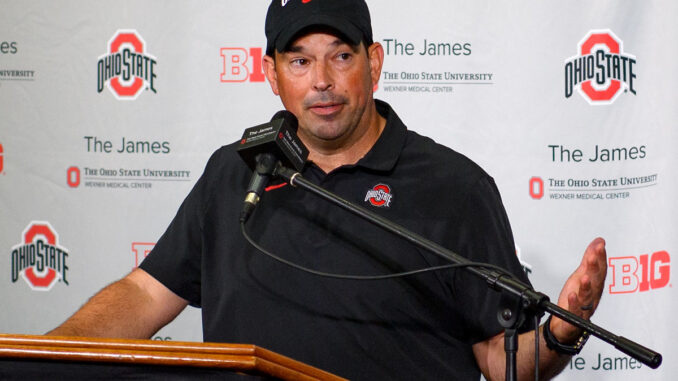
Ryan Day Discloses Striking Concerns for Ohio State Buckeyes
In the realm of college football, few programs command the respect and admiration that the Ohio State Buckeyes do. Under the leadership of Head Coach Ryan Day, the team has achieved remarkable successes, including a national championship victory in early 2025. However, despite these accolades, Coach Day has openly expressed several concerns that could significantly impact the Buckeyes’ future performance and legacy.
1. Navigating the Quarterback Conundrum
The departure of star quarterback Will Howard to the NFL Draft left a void that Coach Day and his staff have been striving to fill. The ensuing quarterback battle has been nothing short of intense, with multiple candidates vying for the coveted starting position. Julian Sayin, a transfer from Alabama, entered the competition with high expectations. However, Lincoln Kienholz, a versatile athlete from South Dakota, has also showcased exceptional skills, complicating predictions about the starting role. Coach Day has emphasized that the decision remains open, with no clear frontrunner emerging as spring practices conclude.
2. Addressing Defensive Vulnerabilities
While the Buckeyes’ offense has often been lauded, Coach Day has acknowledged the need for defensive improvements. In a previous season, the team faced challenges that exposed certain defensive shortcomings. Recognizing this, Coach Day has been proactive in seeking solutions, emphasizing the importance of strategic adjustments and player development to bolster the defense. His commitment to addressing these issues underscores a holistic approach to team development, ensuring that both sides of the ball operate at peak efficiency.
3. Managing Player Workload and Preventing Injuries
The physical demands of college football are immense, and Coach Day has voiced concerns over the wear and tear on his players. An incident involving quarterback Will Howard highlighted the potential risks associated with high usage rates. Coach Day’s awareness of this issue has led to a more measured approach, aiming to balance player utilization with the need to maintain peak performance levels. This strategy not only aims to prevent injuries but also ensures that players remain fresh throughout the grueling season.
4. Navigating the Challenges of Modern College Football
The landscape of college football is rapidly evolving, with factors such as the transfer portal, NIL (Name, Image, Likeness) regulations, and changing recruiting dynamics influencing team compositions. Coach Day has openly discussed the challenges posed by these changes, particularly in maintaining roster stability and team cohesion. The departure of 26 players, including key contributors, serves as a testament to the volatility introduced by these new elements. Coach Day’s transparency regarding these challenges reflects a candid acknowledgment of the complexities facing modern programs.
5. Balancing Fan Expectations with Personal Well-being
The passionate fanbase of Ohio State is both a blessing and a source of immense pressure. Following a narrow loss to Michigan, Coach Day and his family faced severe backlash, including threats that necessitated police protection. This incident shed light on the darker aspects of fan fervor and the personal toll it can take on coaches and their families. Coach Day’s experience underscores the need for a balance between professional commitments and personal well-being, a challenge that many in high-profile coaching positions can relate to.
6. Financial Implications of Competitive Success
Achieving success in college football comes with significant financial considerations. The Buckeyes’ national championship run involved substantial expenditures, including a $20 million investment in roster enhancements. While such investments can yield immediate rewards, they also pose long-term financial challenges. Coach Day’s awareness of these implications highlights the delicate balance between pursuing excellence and ensuring fiscal responsibility. The scrutiny over a $38 million decision further emphasizes the weight of financial decisions in the modern collegiate athletic landscape.
7. The Uncertainty of Coaching Tenure
In the high-pressure world of college football, coaching tenures can be precarious. Despite leading the Buckeyes to a national championship, Coach Day’s position was once considered tenuous, especially after consecutive losses to Michigan. The speculation surrounding his job security serves as a reminder of the volatile nature of coaching careers, where past successes can quickly be overshadowed by recent shortcomings. This environment necessitates a constant balancing act between achieving immediate results and building a sustainable, successful program.
8. The Mental and Emotional Toll of Public Scrutiny
The intense public and media scrutiny that accompanies high-profile coaching positions can be overwhelming. Coach Day’s experiences, including public criticism and personal threats, highlight the emotional challenges inherent in such roles. The ability to navigate this pressure is crucial, not only for personal well-being but also for maintaining team morale and focus. Coach Day’s resilience in the face of adversity serves as a testament to his dedication and fortitude.
9. Embracing Change While Upholding Tradition
Ohio State boasts a rich football legacy, and Coach Day stands at the intersection of honoring tradition while embracing change. The introduction of new playoff formats, such as the 12-team College Football Playoff, presents both opportunities and challenges. Coach Day’s reflections on these changes, particularly regarding scheduling and preparation, underscore the complexities of adapting to evolving structures while striving to maintain competitive excellence. citeturn0search9
10. Ensuring Long-Term Program Sustainability
Beyond immediate concerns, Coach Day is focused on the long-term health and success of the Ohio State football program. This involves strategic planning in areas such as recruiting, player development, and resource allocation. The goal is to build a program that remains competitive at the highest levels year in and year out, adapting to changes in the collegiate athletic landscape while staying true to the core values and traditions that.

Leave a Reply